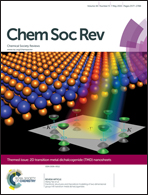Two-dimensional graphene analogues for biomedical applications
Abstract
The increasing demand of clinical biomedicine and fast development of nanobiotechnology has substantially promoted the generation of a variety of organic/inorganic nanosystems for biomedical applications. Biocompatible two-dimensional (2D) graphene analogues (e.g., nanosheets of transition metal dichalcogenides, transition metal oxides, g-C3N4, Bi2Se3, BN, etc.), which are referred to as 2D-GAs, have emerged as a new unique family of nanomaterials that show unprecedented advantages and superior performances in biomedicine due to their unique compositional, structural and physicochemical features. In this review, we summarize the state-of-the-art progress of this dynamically developed material family with a particular focus on biomedical applications. After the introduction, the second section of the article summarizes a range of synthetic methods for new types of 2D-GAs as well as their surface functionalization. The subsequent section provides a snapshot on the use of these biocompatible 2D-GAs for a broad spectrum of biomedical applications, including therapeutic (photothermal/photodynamic therapy, chemotherapy and synergistic therapy), diagnostic (fluorescent/magnetic resonance/computed tomography/photoacoustic imaging) and theranostic (concurrent diagnostic imaging and therapy) applications, especially on oncology. In addition, we briefly present the biosensing applications of these 2D-GAs for the detection of biomacromolecules and their in vitro/in vivo biosafety evaluations. The last section summarizes some critical unresolved issues, possible challenges/obstacles and also proposes future perspectives related to the rational design and construction of 2D-GAs for biomedical engineering, which are believed to promote their clinical translations for benefiting the personalized medicine and human health.

- This article is part of the themed collection: 2D Transition Metal Dichalcogenide (TMD) Nanosheets

 Please wait while we load your content...
Please wait while we load your content...